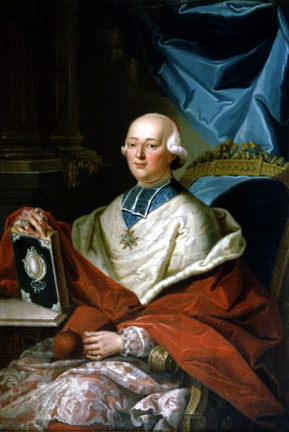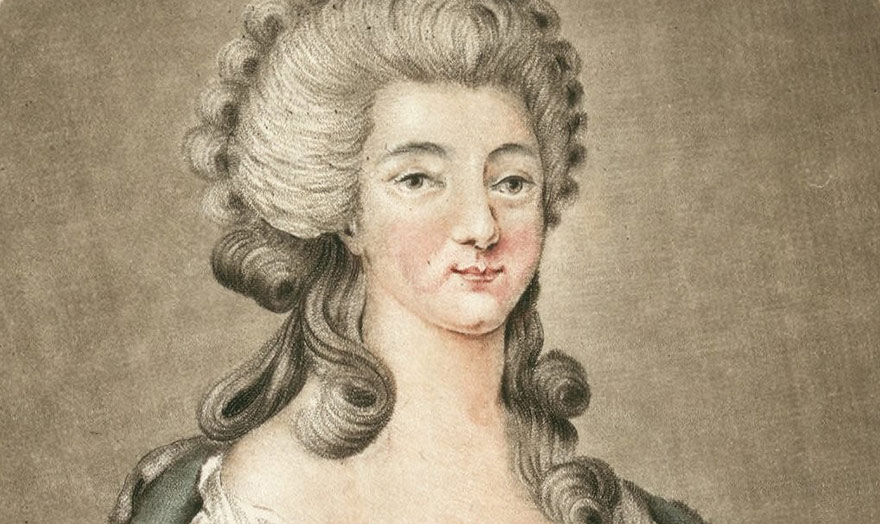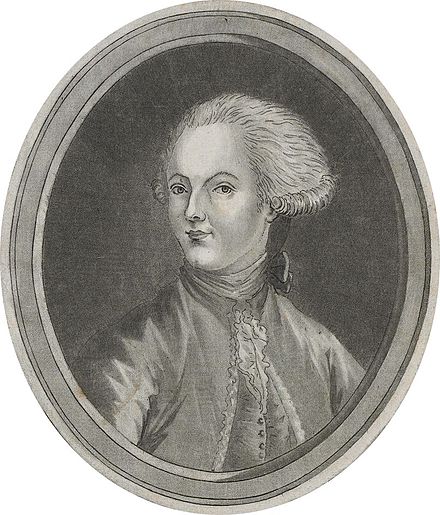The Betrayal of a Queen
By 1785 the formerly popular Marie Antoinette had become a favourite person to hate in France. Tales of her wild behaviour and even wilder spending were grossly exaggerated; nevertheless, gossipers rarely care much for facts. The "affair of the diamond necklace" refers to a scandal which took place int that year and involved a Queen, a Cardinal and a Comtesse.
Cardinal de Rohan had fallen afoul of Empress Maria Theresa during his tenure as ambassador to Vienna in the years 1772-74. Naturally, the Empress made sure that her royal daughter knew all about her dislike for the cardinal; utterly convinced by her mother as to the cardinal's vices Marie Antoinette, too, developed an intense dislike to him. According to her mother the cardinal had attempted to spread vile gossip about the French queen at the Viennese court. When the cardinal returned to Versailles in 1774 he suddenly faced an abysmal future. Although he was endowed with a red hat and a prestigious office he was also very well aware that his position at court could be reversed. This seemed especially likely with the queen being his decided enemy.
 |
| Cardinal de Rohan |
Consequently, he set out to regain favour with the queen consort. In his pursuit hereof he sought the help of a certain Comtesse de La Motte. Her actual name was Jeanne de Valois-Saint-Rémy and the title? Well, she had simply bestowed it on herself in an attempt to get ahead in the world. Jeanne was actually a descendant of Henri II and as such had a certain claim to be counted amongst the aristocracy.
In 1782 the infamous necklace was created. Böhmer and Bassenge - crown jewellers - had designed the extremely lavish necklace. No less than 650 diamonds were set in the necklace which weighed 2600 carats. The price was staggering. When the jewellers presented the necklace to Louis XVI its price had already been reduced but still stood at 1,6 million livres. Both Louis XVI and Marie Antoinette were unwilling to spent such an exorbitant amount of money and turned it down.
 |
| A replica of the infamous necklace - the original being broken down before the revolution |
Meanwhile, lurking in the shadows at court, the Comtesse de La Motte saw an opportunity in the necklace. She had already convinced the cardinal that her and the queen were close friends. Therefore, she now convinced the cardinal to go to the Queen's Grove in the palace garden on the night of 11 August 1784. The cardinal duly went and was convinced that he was to meet the queen incognito. To be sure, he did meet a woman hiding in the shadows - but it was not Marie Antoinette. Little known to the cardinal the woman was an imposter who masqueraded as the queen. This imposter was in fact a prostitute by the name of Marie-Nicole Le Guay; she had been discovered by none other than the Comte de La Motte. He had remarked how similar she looked to the queen which undoubtedly inspired a few thoughts. From her place in the shadows she assured the cardinal that his place at court would be redeemed.
The comtesse had furthermore convinced de Rohan that he would enhance his chances of returning to the queen's good graces if he bought the necklace on her behalf. This she finally succeeded in on 29 January. She had assured him that the queen really desired the necklace but did not have the nerve to buy it with her popularity already in the dumps. The real treachery - if it had not already played out - came when the queen's signature was forged and put to a document which agreed both to the price and the cardinal as her go-between.
 |
| The Comtesse de La Motte |
Cardinal de Rohan wasted no time and immediately turned to the jewellers; these asked no questions since they were pleased to finally have a buyer. On 1 February 1785 the infamous necklace was handed over to the cardinal's possession. Böhmer - never doubting that the queen was his actual client - sent her a letter on 12 July. Understandably, poor Marie Antoinette was utterly confused when she received it since she had no knowledge of the affair nor the transaction. Thinking that it was merely a stunt to once again push the necklace on her, she destroyed the letter. When he heard nothing from the queen he turned to Madame Campan and requested an answer to when he might receive the remainder of the money.
The queen was complexed and demanded an explanation of the jeweller. He told the queen everything about his deal with Cardinal de Rohan.
Not surprisingly, both the king and queen were outraged that such a deception was carried out in their names. On 15 August the cardinal was arrested by the king's guards in the Hall of Mirrors. He was transported to the Bastille. In Marie Antoinette's point of view the scheme was not unlike what could be expected from a character such as the cardinal. After all, she had been warned by her trusted mother. However, the Parlement de Paris was not as willing to condemn the cardinal. In May 1785 they acquitted him.
Although he escaped a prison spell, the Cardinal de Rohan was finished at court. The king stripped him of all his offices and sent him into exile.
The queen was livid. It certainly did nothing to ease her disappointment and rage that the public welcomed the cardinal's sentence. It was considered to be a victory over the hated queen - never mind the matter of guilt.
 |
| Marie Antoinette |
During his incarceration the cardinal had not hesitated to give away his accomplice, the Comtesse de La Motte. She was promptly arrested. Her trial ended differently than the cardinal's had and was far more scandalous. In April 1786 she admitted that she had paid Le Guay to masquerade as the queen but she insisted that she had only done it as an act of revenge. The Comtesse attempted to convince the court that the cardinal had continually pressed her to intercede on his behalf with the queen. Furthermore, she claimed that she and the cardinal were lovers - as can be expected the cardinal completely denied it.
The court found her guilty and she was branded with a large "V" (for Voleuse = thief) as well as flogged. Originally, she had been sentenced to life in Salpêtrière Prison in Paris. That should have been the end of that but this story had another twist. On 5 June 1787 she managed to escape and fled to England. Here, she published her memoirs which ultimately aims at defaming Marie Antoinette. Her life would be cut unexpectedly short when she died from a fall in 1791 - two years before the queen.
Surprisingly, Marie-Nicole Le Guay was also acquitted. Even the Comtesse de La Motte admitted that the hired lady was immensely stupid; the comtesse claimed that she had not even realized that she was impersonating the queen. Following their interrogation of Le Guay the court believed her.
As for the Comte de La Motte he had been sentenced in absentia to life as a galley slave. Luckily for him, he had already left France and managed to escape any punishment at all. The forger, Réteaux, was permanently exiled from France.
 |
| The Comte de La Motte |
It should have been clear that the queen had been innocent of any wrongdoing in the scheme. This did not play well with the image her enemies had been so successful in spreading, though. Although the court cases were watched with eagerness by both Versailles and Paris neither seemed to quite acquit the queen. The queen was well on her way to becoming the most hated woman in France and this merely added fuel to the fire.
Marie Antoinette herself could do nothing. The Parisians were determined to make a villain of her and even such a clear-cut case of fraud was twisted against the queen. In light of this it can hardly be wondered at that Marie Antoinette continued to habour a deep resentment towards the cardinal and the comtesse.
The damage had been done to Her Majesty's reputation. Thomas Carlyle was quite right when he wrote that "the odium of the Diamond Necklace embittered all the Queen's future life, and followed her to the very steps of the guillotine".
What happened to the necklace?
When the necklace was delivered on that first day of February 1785 it was brought to the house of the Comte and Comtesse de La Motte. Here, it was put into the care of a man whom the jewellers believed to be a valet of the queen's. He was, however, a man by the name of Rétaux - the very same man who had forged the queen's signature.
From its brief stay in the Comte's household it was shipped posthaste to London and Amsterdam where it was broken up. The value of the necklace itself was still dazzling but due to its infamy it would be too easy to recognize. The Comtesse even had the nerve to wear some of the larger diamonds in earrings which she sported at court.

This is incredible. Reality does become better than fiction here!
ReplyDelete